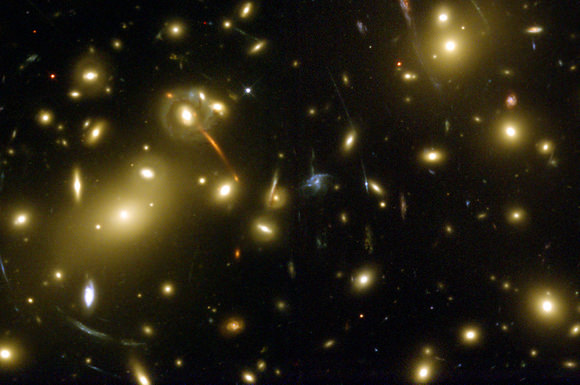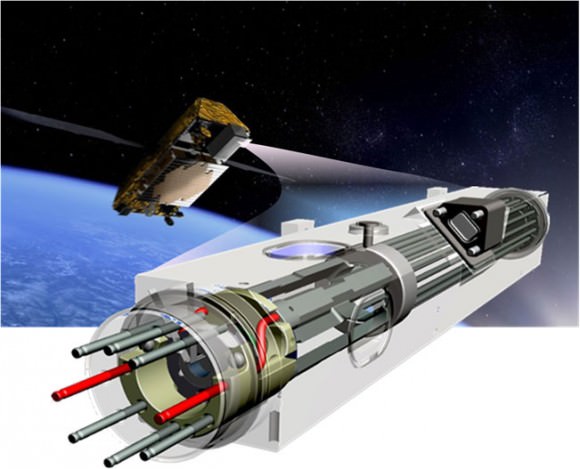You know the old saying: “if you want to hide something, put it in plain sight?” Well, according to a new proposal by two professors of physics, this logic may be the reason why scientists have struggled for so long to find the mysterious mass that is believed to comprise 27% of the matter in the universe.
In short, these two physicists believe that dark matter can be found the same way the you can find the fastest route to work: by consulting the Global Positioning System.
Andrei Derevianko, of the University of Nevada, Reno, and Maxim Pospelov, of the University of Victoria and the Perimeter Institute for Theoretical Physics in Canada, proposed this method earlier this year at a series of renowned scientific conferences, where it met with general approval.
Their idea calls for the use of GPS satellites and other atomic clock networks and comparing their times to look for discrepancies. Derevianko and Pospelov suggest that dark matter could have a disruptive affect on atomic clocks, and that by looking at existing networks of atomic clocks it might be possible to spot pockets of dark matter by their distinctive signature.
The two are starting to test this theory by analyzing clock data from the 30 GPS satellites, which use atomic clocks for everyday navigation. Correlated networks of atomic clocks, such as the GPS and some ground networks already in existence, can be used as a powerful tool to search for the topological defect dark matter where initially synchronized clocks will become desynchronized.

“Despite solid observational evidence for the existence of dark matter, its nature remains a mystery,” Derevianko, a professor in the College of Science at the University, said. “Some research programs in particle physics assume that dark matter is composed of heavy-particle-like matter. This assumption may not hold true, and significant interest exists for alternatives.”
Their proposal builds on the idea that dark matter could come from cracks in the universe’s quantum fields that could disturb such fundamental properties as the mass of an electron, and have an effect on the way we measure time. This represents a break from the more conventional view that dark matter consists of subatomic particles such as WIMPs and axions.
“Our research pursues the idea that dark matter may be organized as a large gas-like collection of topological defects, or energy cracks,” Derevianko said. “We propose to detect the defects, the dark matter, as they sweep through us with a network of sensitive atomic clocks. The idea is, where the clocks go out of synchronization, we would know that dark matter, the topological defect, has passed by. In fact, we envision using the GPS constellation as the largest human-built dark-matter detector.”
Derevianko is collaborating on analyzing GPS data with Geoff Blewitt, director of the Nevada Geodetic Laboratory, also in the College of Science at the University of Nevada, Reno. The Geodetic Lab developed and maintains the largest GPS data processing center in the world, able to process information from about 12,000 stations around the globe continuously, 24/7.

Blewitt, also a physicist, explained how an array of atomic clocks could possibly detect dark matter.
“We know the dark matter must be there, for example, because it is seen to bend light around galaxies, but we have no evidence as to what it might be made of,” he said. “If the dark matter were not there, the normal matter that we know about would not be sufficient to bend the light as much as it does. That’s just one of the ways scientists know there is a massive amount of dark matter somewhere out there in the galaxy. One possibility is that the dark matter in this gas might not be made out of particles like normal matter, but of macroscopic imperfections in the fabric of space-time.
“The Earth sweeps through this gas as it orbits the galaxy. So to us, the gas would appear to be like a galactic wind of dark matter blowing through the Earth system and its satellites. As the dark matter blows by, it would occasionally cause clocks of the GPS system to go out of sync with a tell-tale pattern over a period of about 3 minutes. If the dark matter causes the clocks to go out of sync by more than a billionth of a second we should easily be able to detect such events.”
“This type of work can be transformative in science and could completely change how we think about our universe,” Jeff Thompson, a physicist and dean of the University’s College of Science, said. “Andrei is a world class physicist and he has already made seminal contributions to physics. It’s a wonder to watch the amazing work that comes from him and his group.”
Derevianko teaches quantum physics and related subjects at the University of Nevada, Reno. He has authored more than 100 refereed publications in theoretical physics. He is a fellow of the American Physical Society, a Simons fellow in theoretical physics and a Fulbright scholar. Among a variety of research topics, he has contributed to the development of several novel classes of atomic clocks and precision tests of fundamental symmetries with atoms and molecules.
Their research appeared earlier this week in the online version of the scientific journal Nature Physics, ahead of the print version.
Further Reading: University of Nevada


please post the results of this experiment when the results are in. thanks mr. Williams.
To quote: “… cracks in the universe’s quantum fields …”
???
It must be my supreme niavete’. Are there other references to cracks in quantum fields in contemporary works?
Might there be “cracks” in other fields? – such as a magnetic field?
A gravity field?
What is the nature of a crack in a quantum field?
In fact, what is the nature of the quantum field of which they are speaking?
“In fact, what is the nature of the quantum field of which they are speaking?”
http://en.wikipedia.org/wiki/Quantum_field_theory
😉